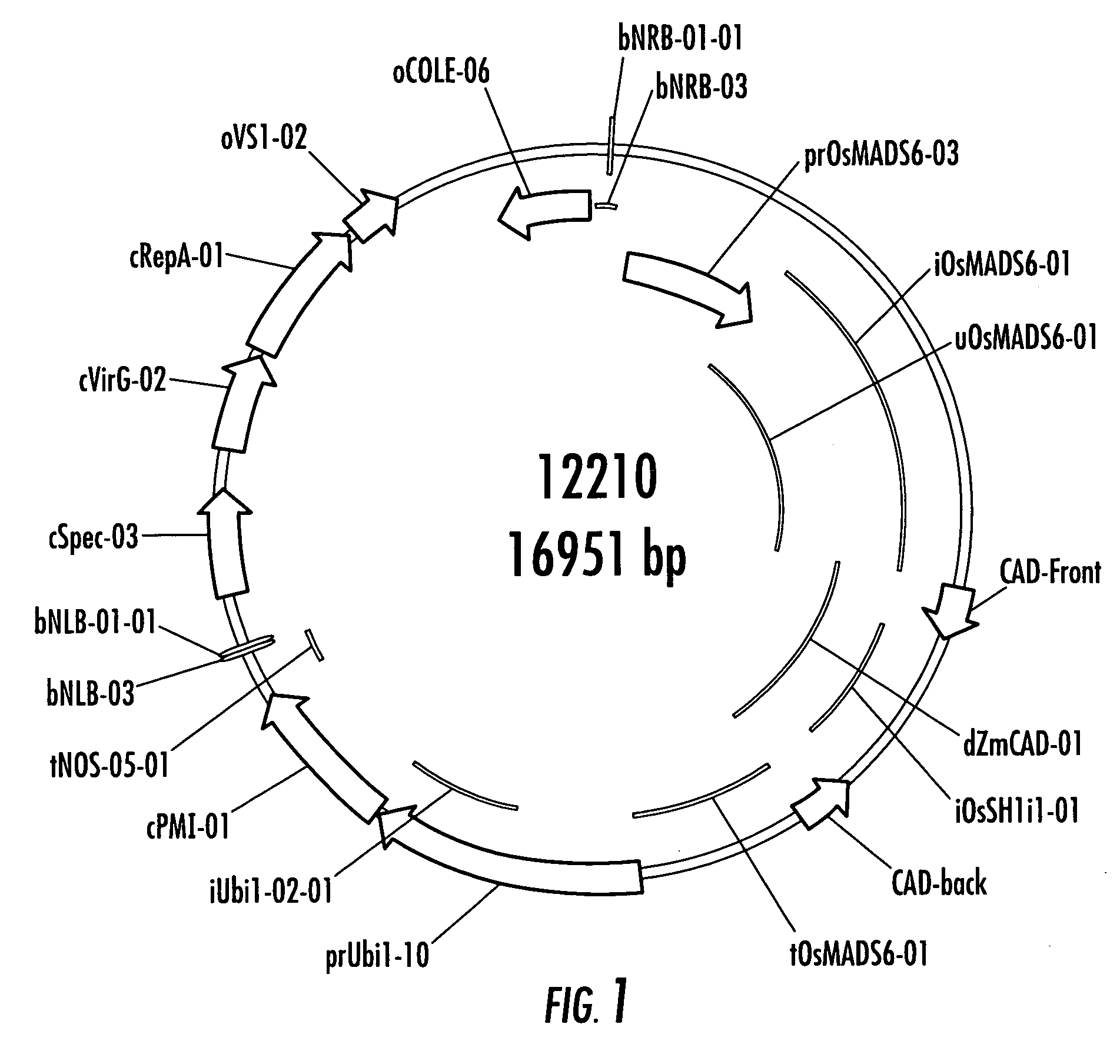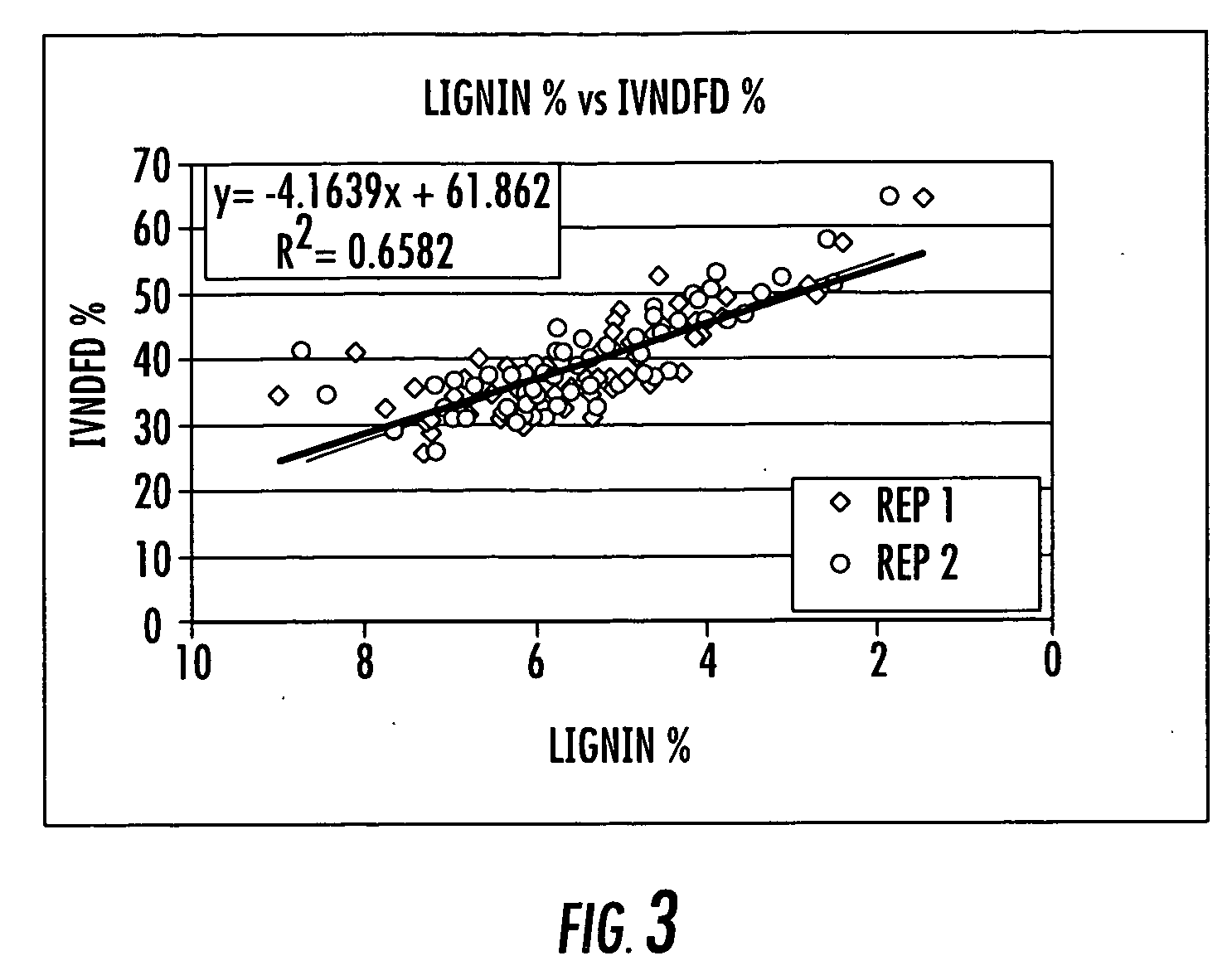Methods and genetic constructs for modification of lignin composition of corn cobs
- Summary
- Abstract
- Description
- Claims
- Application Information
AI Technical Summary
Benefits of technology
Problems solved by technology
Method used
Image
Examples
example 1
Agrobacterium Transformation of Maize—Immature embryos
Preparation of Ear
[0143] Harvest ears when immature embryos in the center kernels are approximately 0.5-1.0 mm.
[0144] Shuck and sterilize ears in a solution of 20% Chlorox and 3 drops Tween / liter of solution. Put on an orbital shaker for 20 minutes.
[0145] Rinse ears three times with sterile ddH2O.
[0146] In a sterile environment cut off the tops of the kernels. Rest the ear on a sterile Petri dish and isolate the immature embryos.
Preparing Inoculation Solution for Transformation.
[0147] To 100 mL of LP-Lsinf. Medium, add 50 μl of acetosyringone (AS) stock solution (40 mg / ml stock / mL) for a final concentration of 100 μM AS. [0148] Pipet 4 ml (2.5) of the infection medium into a 10 ml disposable tube. [0149] Set up Eppendorf tubes for collecting the embryos at this time and add ˜1.4 ml infection medium with AS to them.
Preparation of Agrobacterium Suspension [0150] Take one loop of Agrobacterium and re-suspend it by vortex ...
example 2
T1 CAD event selection pSyn12210
[0169] T1 cob samples of a total 15 events (10 low, 3 medium and 2 high copy) include 65 lines (28 low, 14 medium, 5 high copy and 18 null control lines) were sent to MSU for NDF (fiber), ADL (lignin), IVNDFD (in vitro NDF digestibility) analysis. 3 BM3 isolines and 2 hybrid checks were also included. We compared the difference among the lines (transgenic vs. null) of the same event, among the events, or among low, medium and high copy events with the BM3 positive or negative controls and hybrid check. Although a few of these made it into the top 16 lines mentioned below, none of them showed consistent reduction in lignin in future tests. The data are in Table 1, and the methods used for analysis are given below.
T1 COMT Event Selection (pSyn 12345)
[0170] T1 cob analysis: total 41 events (23 low, 13 medium, and 5 high copy) include 131 lines (24 low, 13 medium, 8 high copy and 20 null control lines) were sent to MSU for analysis (ADL, NDF, IVNDFD)...
example 3
CAD / COMT Double Knockouts
[0241] Co-expression of dsRNAi constructs for CAD & COMT driven by the OsMADs6 promoter can be achieved in single construct. Transgenic maize events containing such constructs are produced using the transformation protocol set forth in Example 1. The sequences of the OsMADs6 promoter and of the RNAi constructs are as presented, and the analyses set forth above are used to determine lignin content etc. Cobs with decreased lignin content produced using this method can be used to the same extent and for the same purposes as those produced using the plasmids of FIG. 1 or 2.
PUM
| Property | Measurement | Unit |
|---|---|---|
| Fraction | aaaaa | aaaaa |
| Fraction | aaaaa | aaaaa |
| Fraction | aaaaa | aaaaa |
Abstract
Description
Claims
Application Information
 Login to View More
Login to View More - R&D
- Intellectual Property
- Life Sciences
- Materials
- Tech Scout
- Unparalleled Data Quality
- Higher Quality Content
- 60% Fewer Hallucinations
Browse by: Latest US Patents, China's latest patents, Technical Efficacy Thesaurus, Application Domain, Technology Topic, Popular Technical Reports.
© 2025 PatSnap. All rights reserved.Legal|Privacy policy|Modern Slavery Act Transparency Statement|Sitemap|About US| Contact US: help@patsnap.com



